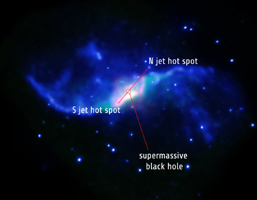
Annotated Version
Click on the image for larger versionA composite image of the spiral galaxy NGC 4258 showing X-ray emission observed with NASA's Chandra X-ray Observatory (blue) and infrared emission observed with NASA's Spitzer Space Telescope (red and green).
The infrared emission is produced by hydrogen molecules. A labeled version of the image shows the direction of radio jets, along with the location of the supermassive black hole driving these jets and "hotspots," where the jets are striking gas in the galaxy. The X-ray and hydrogen emission are both thought to be caused by shocks, similar to a sonic boom from a supersonic plane. The similarity in location between the X-ray and hydrogen emission and the radio jets implies that the jets have caused the shocks.
NASA's Jet Propulsion Laboratory, Pasadena, Calif., manages the Spitzer Space Telescope mission for NASA's Science Mission Directorate, Washington. Science operations are conducted at the Spitzer Science Center at the California Institute of Technology in Pasadena. Spacecraft operations are based at Lockheed Martin Space Systems Company, Littleton, Colorado. Data are archived at the Infrared Science Archive housed at the Infrared Processing and Analysis Center at Caltech. Caltech manages JPL for NASA.
For more information about Spitzer, visit http://spitzer.caltech.edu and http://www.nasa.gov/spitzer.

